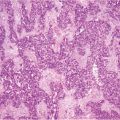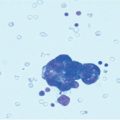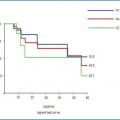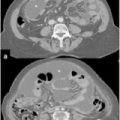, Francesca Guerini, Andrea Zanoni and Giovanni de Manzoni
(1)
Department of Surgery, Upper G.I. Surgery Unit, Borgo Trento Hospital, Verona, Italy
5.1 Introduction
An accurate staging system for cancer diseases aims at providing a prognostic indication that is as accurate as possible. It also aids in treatment planning, evaluating therapeutic results, and interchanging information between different treatment centers. Peritoneal carcinomatosis (PC), once considered as an end stage of neoplastic disease, now can and should be staged: the better understanding of the biology and pathways of tumor dissemination with intraperitoneal spread has, in fact, prompted the concept that PC is not a manifestation of a systemic diffusion of the disease but is a locoregional entity. In particular, when we speak about PC, we do not refer to a metastasis in the common sense of the word because, as previously illustrated, this disease does not follow hematogenous or lymphatic dissemination but spreads via different pathways. Furthermore, Sugarbaker’s research [1] created a new mindset toward surgical treatment of PC, the approach to which now has curative intent. In Sugarbaker’s discussion, PC from different cancers is considered: gastrointestinal neoplasms, such as gastric cancer (GC), colorectal cancer (CRC), and appendiceal cancer [pseudomyxoma peritonei (PMP)]; gynecological cancers, such as ovarian cancer (OC); and malignant peritoneal mesothelioma (MPM). All these pathologies have a frequent peritoneal spread, and all follow different diffusion patterns. The classification of peritoneal metastasis considers three factors: (1) extension of peritoneal involvement (2) type of primary, (3) residual disease. These are the cornerstones of the staging system.
5.2 Extension of Peritoneal Involvement
PC staging is difficult, even with imaging methods. Therefore, intraoperative exploration is an important factor, and quantitative prognostic indicators play an important role in guiding treatment selection. There remain many concerns related to diagnostic descriptive methods, which are first of all based on the fact that calculations are made by different surgeons. Nonetheless, studies in this direction show good agreement. Two quantitative staging systems are currently in use: the Gilly PC staging system, and the Peritoneal Cancer Index (PCI).
5.2.1 Gilly Peritoneal Carcinomatosis Staging
The Gilly PC staging format was first described in Lyon, France [2] in 1994. This prognostic tool accounts for size and partially for distribution, localized or diffuse, of malignant granulations (Table 5.1). Two advantages of this system are ease of use and reproducibility. It also has an important prognostic role: it allows identification of four different classes on the basis of different median survival rates, and only patients with stages 1 and 2 are candidate to surgery [3]. The usefulness of this technique was shown in the multicentric prospective Evolution of Peritoneal Carcinomatosis (EVOCAPE) study [4], which gathered data from 370 patients with PC from nongynecologic malignancies. Studies [5] focusing on GC, moreover, observed that in a resectable neoplasia with carcinomatosis stages 1 and 2, the 1-year survival rates was 80 % versus 10 % for patients with unresectable primary tumors in carcinomatosis stages 3 and 4.
Stage | Peritoneal carcinomatosis description |
|---|---|
0 | No macroscopic disease |
1 | Malignant granulations < 5 mm in diameter; localized in one part of the abdomen |
2 | Malignant granulations < 5 mm in diameter; diffuse to the whole abdomen |
3 | Malignant granulations from 5 mm to 2 cm in diameter |
4 | Localized or diffuse large malignant masses (> 2 cm in diameter) |
A limit of the Gilly staging system is that it does not clarify whether peritoneal spread is potentially resectable or not [6]. A second weakness concerns failure to quantify the distribution of peritoneal surface implants in stages 3 and 4 because in these categories, nodule distribution is not taken into account; only size is considered. In fact, a different prognosis can be expected if carcinomatosis is confined to one portion of the abdomen, regardless of tumor implant size. Despite these limitations, the Gilly staging system was proven to be an important prognostic indicator in several clinical trials [7–9].
5.2.2 Peritoneal Cancer Index
The PCI was first described by Jacquet and Sugarbaker [10] and established at the Washington Cancer Institute. This classification system scores lesion distribution on the peritoneal surface on the basis of their size, producing a quantitative score. First, the abdomen is divided in nine regions by two transverse and two sagittal straight lines. The upper transverse plane is located beneath the costal margin, and the lower transverse plane is placed at the anterior superior iliac spine; the sagittal planes divide the abdomen into three equal sectors. The regions are then numbered starting from the umbilical area, which is assigned 0, proceeding in a clockwise direction from space 1, under the right hemidiaphragm, to space 8, located in the right side. Regions from 9 to12 divide the small bowel into upper and lower jejunum and upper and lower ileum. To make the indexing tool more quantitative and reproducible, each region is also defined by the anatomic structures located in each region (Table 5.2).
Regions | Anatomic structures |
|---|---|
0 | Central: Midline abdominal incision; entire greater omentum; transverse colon |
1 | Right upper: superior surface of the right lobe of the liver; undersurface of the right hemidiaphragm; right retrohepatic space |
2 | Epigastrium: epigastric fat pad; left lobe of the liver; lesser omentum; falciform ligament |
3 | Left upper: undersurface of the left hemidiaphragm; spleen; tail of pancreas; anterior and posterior surfaces of the stomach] |
4 | Left flank: descending colon; left abdominal gutter |
5 | Left lower: pelvic sidewall lateral to the sigmoid colon; sigmoid colon |
6 | Pelvis: female internal genitalia with ovaries, tubes, and uterus; bladder, pouch of Douglas; rectosigmoid colon |
7 | Right lower: right pelvic sidewall; cecum; appendix |
8 | Right flank: right abdominal gutter; ascending colon |
9 | Upper jejunum |
10 | Lower jejunum |
11 | Upper ileum |
12 | Lower ileum |
Second, the Lesion-Size (LS) score is determined to assess the diameter of the largest tumor implant (Table 5.3). A confluence of disease is automatically scored as LS-3; primary tumors or recurrences localized at the primary site and that can be removed definitively are excluded from the assessment.
Score | Description |
|---|---|
LS-0 | No implants seen |
LS-1 | Implants < 0.5 cm |
LS-2 | Implants between 0.5 and 5 cm |
LS-3 | Implants > 5 cm or a confluence of disease |
Lesion sizes are then added to obtain a number ranging from 0 to 39. In invasive cancers in which cytoreductive surgery (CRS) and perioperative intraperitoneally administered chemotherapy (IP-CHT) are used as treatment, PCI gives a threshold value for favorable versus poor prognosis and moreover allows estimation of the probability of complete cytoreduction.
There are two important limits: Sugarbaker and Jablonski [11] indicated that PCI was a meaningful score for colon cancer but not for mucinous appendiceal tumors, such as PMP, and for minimally aggressive mesothelioma. These diseases are, in fact, noninvasive, and a PCI of 39 can easily be converted to 0 using CRS. Furthermore, there is a low probability of recurrences after complete cytoreduction in these pathologies with perioperative intraperitoneal chemotherapy; therefore, the PCI has no prognostic implication in such cases [12]. A second limit of PCI staging is that it does not give a qualitative score of the regions, considering the invasion of the hepatoduodenal ligament and small-intestine mesentery, at the same level of other regions. Rather, invasion of these structures is considered a contraindication to surgery.
5.3 Type of Primary
Several preoperative scoring systems have been advocated to predict the optimal resectability of PC. Different classification systems have been developed for different neoplastic pathologies in order to provide a detailed picture of locoregional disease.
5.3.1 Peritoneal Carcinomatosis in Colon Cancer
In the sixth edition of the AJCC Cancer Staging Manual [13,15], stage pT4a indicates tumors invading adjacent structures or organs, whereas pT4b indicates tumors involving visceral peritoneum. In order to better classify this stage, the PCI is used. This was, in fact, described for the first time in colon cancer. At The Netherlands Cancer Institute [16], however, the Simplified PCI (SPCI) has also been established, which has also been used for PMP staging. As with the PCI, this system calculates tumour load, quantitatively scoring the volume of localizations in each region; however, it considers only seven regions, reaching a maximum score of 21 (Table 5.4). The SPCI was developed for practical convenience to maximize simplicity and proved useful in patients with CRC. Using the seven anatomic regions, Verwaal et al. and Swellengrabe et al. [17, 18] observed that in patients in whom five of the seven regions were affected or in whom SPCI > 12 was found, the possibility of treatment benefits were significantly diminished. They also attempted to correlate SPCI and postoperative course: patients with a high SPCI have greater morbidity and mortality. However, there are two defects: First, the epigastric region—important because it may influence the Completeness of Cytoreduction score (CC)—is not considered separately. Second is the Dutch group—s misuse of their own tool: in their recent publications, they report a survival analysis and toxicity assessment with SPCI, but regions only were evaluated, and tumor size was not indicated.
Tumor size and abdominal regions | |
|---|---|
Tumor measured as | |
Large | > 5 cm |
Moderate | 1–5 cm |
Small | < 1 cm |
None | – |
Abdominal regions | |
1 | Pelvis |
2 | Right lower abdomen |
3 | Greater omentum, transverse colon and spleen |
4 | Right subdiaphragmatic area |
5 | Left subdiaphragmatic area |
6 | Subhepatic and lesser omental area |
7 | Small bowel and small-bowel mesentery |
A separate consideration of prior surgical score (PSS) [19] is required. According to Sugarbaker, who designed this simple scoring system, prior surgical exeresis plays a role in tumor cell diffusion over the peritoneum. PSS has been identified as a prognostic factor in several studies, but its value resulted in being of little interest. This classification system quantifies surgical extent prior to definitive treatment: the first operation is equivalent to a prior attempt at complete cytoreduction without using perioperative IP-CHT. The assessment uses a diagram similar to that for PCI but excludes abdominopelvic regions 9–12 (Table 5.5). The PSS is of prognostic value in PC secondary to PMP and primary ovarian tumors and MPM. In PMP treated using combined therapy, survival of patients with a PSS 0—2 was 70% at 5 years; with a prior surgical score of 3, the 5-year survival was 51 % (p = 0.001) [20]. When managing carcinomatosis, the extent of prior resection before definitive cytoreduction with IP-CHT has, in fact, a negative impact on survival. Essentially, PSS “shows that the greater the surgery the poorer the results of carcinomatosis treatment” [19]. This occurs because of the cancer-cell-entrapment phenomenon: cancer imbedded in scar tissue is difficult or impossible to remove by peritonectomy or to eradicate using IP-CHT.
Score | Description |
|---|---|
0 | No prior surgery or biopsy only |
1 | One region with prior surgery |
2 | Two to five regions previously dissected |
3 | More than five regions previously dissected |
5.3.2 Peritoneal Carcinomatosis in Gastric Cancer
In the most widely used staging system, the TNM, carcinomatosis is still associated with stage M. In the latest (seventh edition) of the AJCC Cancer Staging Manual [21], positive peritoneal lavage is considered an M1 (stage IV), similar to macroscopic PC.
The Japanese Research Society for Gastric Cancer originally classified peritoneal disease from primary gastric tumors according to location; they also perform a cytological examination using peritoneal washing fluid. For the original classification, a “P factor” is given to patients with carcinomatosis from GC, which are then classified into five categories [22] (Table 5.6). The classification is very simple, validated for gastric malignancy, frequently applied, and also used in patients with carcinomatosis from recurrent GC. It was shown to be an important prognostic factor in Japanese studies [23–26], which reported a significantly lower survival rate after treatment in patients with P3 carcinomatosis versus those with P2 or P1. One criticism is perhaps that PC size is not taken into consideration. Furthermore, a major limit of the staging system is its inability to describe carcinomatosis accurately by failing to indicate its distribution within the different regions of the abdominal cavity. We believe, however, that in a context of aggressive and difficult unresectable carcinomatosis, such as PC from GC, obtaining a photograph of intraperitoneal diffusion is not so important: the fundamental distinction is the difference between carcinomatosis confined to adjacent organs and diffuse and/or dotted carcinomatosis.
Table 5.6
Peritoneal Carcinomatosis (PC) staging, Japanese Research Society for Gastric Cancer. (Modified from [22])
Stage | Description |
|---|---|
P0/Cy0 | No carcinomatosis seen by the surgeon or established at the time of surgery |
P0/Cy1 | No macroscopic PC but a positive peritoneal wash cytology |
P1 | PC in the upper abdomen, immediately adjacent to the stomach and above the transverse colon |
P2 | Scattered implants; countable pc in peritoneal cavity but few in number |
P3 | Numerous implants throughout the abdomen and pelvis |
5.3.3 Peritoneal Carcinomatosis in Ovarian Cancer
Incomplete TNM staging in assessing peritoneal dissemination of OC, despite it being a frequent occurrence of the disease, led to the development of different carcinomatosis staging systems. Fagotti et al. [27] developed a laparoscopybased score for predicting surgical resectability. Eight laparoscopic features were investigated as potential indicators of surgical outcome:
Presence of ovarian masses (unilateral or bilateral)
Omental cake
Diaphragmatic carcinomatosis
PC
Mesenteric retraction
Bowel invasion
Stomach infiltration
Liver metastases
These satisfied the basic inclusion criteria, and a final predictive index value of 2 was assigned to each one. In the final model, a predictive index score ≥8 identified patients undergoing suboptimal surgery with a specificity of 100 %.
Brun et al. [28] modified this score (Fagotti-modified score) and evaluated its relevance in identifying patients appropriate for optimal CRS. It was at least as accurate as the original Fagotti score in selecting patients with advanced stage OC who could possibly undergo optimal CRS. A modified score was constructed by selecting four of the seven parameters:
Diaphragmatic carcinomatosis
Mesenteric retraction
Stomach infiltration
Liver metastases
A modified score ≥ 4 was associated with suboptimal cytoreduction, with a specificity of 100 % and an accuracy of 56 %. Chereau et al. [29, 30] presented a comparative analysis of different evaluation scores applied to a series of patients who were candidates for interval debulking surgery. They found an 86 % success rate using the Fagotti score and 91 % with the Fagotti-modified score, demonstrating a strong correlation between these scores and so justifying their relevance in evaluating the spread of carcinomatosis. A prognostic role was not an aim of that study.
Stay updated, free articles. Join our Telegram channel

Full access? Get Clinical Tree







